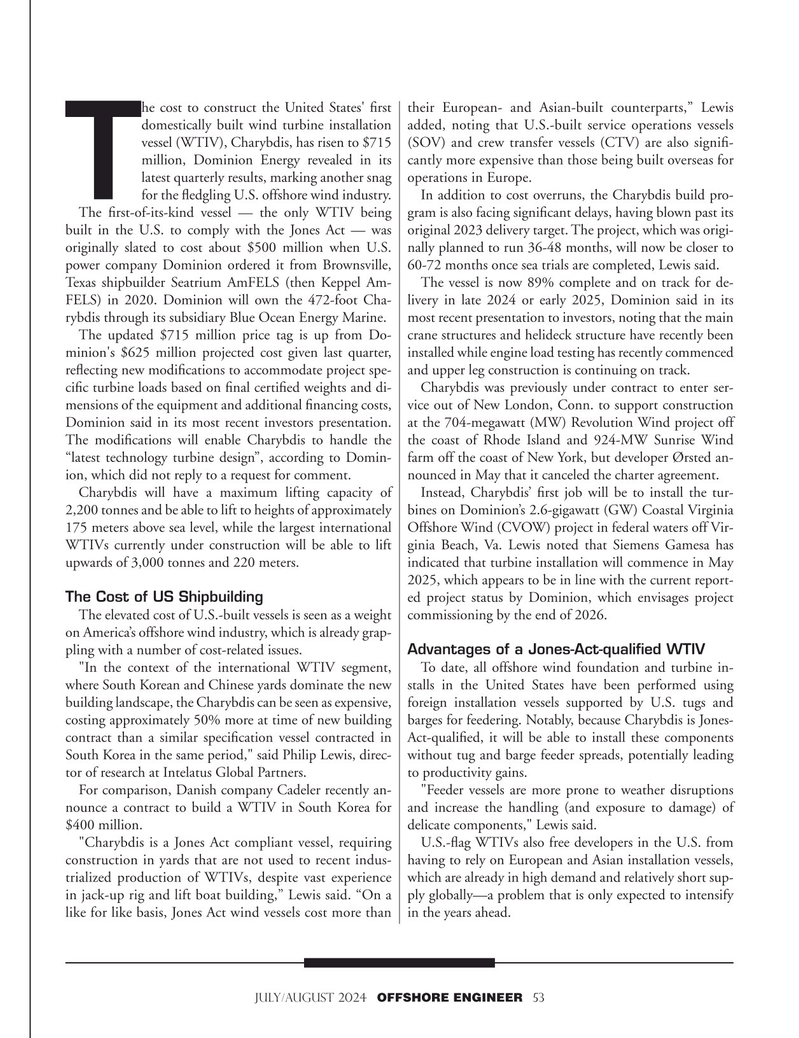
Page 53: of Offshore Engineer Magazine (Jul/Aug 2024)
Read this page in Pdf, Flash or Html5 edition of Jul/Aug 2024 Offshore Engineer Magazine
he cost to construct the United States' frst their European- and Asian-built counterparts,” Lewis domestically built wind turbine installation added, noting that U.S.-built service operations vessels vessel (WTIV), Charybdis, has risen to $715 (SOV) and crew transfer vessels (CTV) are also signif- million, Dominion Energy revealed in its cantly more expensive than those being built overseas for latest quarterly results, marking another snag operations in Europe.
T for the fedgling U.S. offshore wind industry. In addition to cost overruns, the Charybdis build pro-
The frst-of-its-kind vessel — the only WTIV being gram is also facing signifcant delays, having blown past its built in the U.S. to comply with the Jones Act — was original 2023 delivery target. The project, which was origi- originally slated to cost about $500 million when U.S. nally planned to run 36-48 months, will now be closer to power company Dominion ordered it from Brownsville, 60-72 months once sea trials are completed, Lewis said.
Texas shipbuilder Seatrium AmFELS (then Keppel Am- The vessel is now 89% complete and on track for de-
FELS) in 2020. Dominion will own the 472-foot Cha- livery in late 2024 or early 2025, Dominion said in its rybdis through its subsidiary Blue Ocean Energy Marine. most recent presentation to investors, noting that the main
The updated $715 million price tag is up from Do- crane structures and helideck structure have recently been minion's $625 million projected cost given last quarter, installed while engine load testing has recently commenced refecting new modifcations to accommodate project spe- and upper leg construction is continuing on track.
cifc turbine loads based on fnal certifed weights and di- Charybdis was previously under contract to enter ser- mensions of the equipment and additional fnancing costs, vice out of New London, Conn. to support construction
Dominion said in its most recent investors presentation. at the 704-megawatt (MW) Revolution Wind project off
The modifcations will enable Charybdis to handle the the coast of Rhode Island and 924-MW Sunrise Wind “latest technology turbine design”, according to Domin- farm off the coast of New York, but developer Ørsted an- ion, which did not reply to a request for comment. nounced in May that it canceled the charter agreement.
Charybdis will have a maximum lifting capacity of Instead, Charybdis’ frst job will be to install the tur- 2,200 tonnes and be able to lift to heights of approximately bines on Dominion’s 2.6-gigawatt (GW) Coastal Virginia 175 meters above sea level, while the largest international Offshore Wind (CVOW) project in federal waters off Vir-
WTIVs currently under construction will be able to lift ginia Beach, Va. Lewis noted that Siemens Gamesa has upwards of 3,000 tonnes and 220 meters. indicated that turbine installation will commence in May 2025, which appears to be in line with the current report-
The Cost of US Shipbuilding ed project status by Dominion, which envisages project
The elevated cost of U.S.-built vessels is seen as a weight commissioning by the end of 2026.
on America’s offshore wind industry, which is already grap- pling with a number of cost-related issues. Advantages of a Jones-Act-qualified WTIV "In the context of the international WTIV segment, To date, all offshore wind foundation and turbine in- where South Korean and Chinese yards dominate the new stalls in the United States have been performed using building landscape, the Charybdis can be seen as expensive, foreign installation vessels supported by U.S. tugs and costing approximately 50% more at time of new building barges for feedering. Notably, because Charybdis is Jones- contract than a similar specifcation vessel contracted in Act-qualifed, it will be able to install these components
South Korea in the same period," said Philip Lewis, direc- without tug and barge feeder spreads, potentially leading tor of research at Intelatus Global Partners. to productivity gains.
For comparison, Danish company Cadeler recently an- "Feeder vessels are more prone to weather disruptions nounce a contract to build a WTIV in South Korea for and increase the handling (and exposure to damage) of $400 million. delicate components," Lewis said.
"Charybdis is a Jones Act compliant vessel, requiring U.S.-fag WTIVs also free developers in the U.S. from construction in yards that are not used to recent indus- having to rely on European and Asian installation vessels, trialized production of WTIVs, despite vast experience which are already in high demand and relatively short sup- in jack-up rig and lift boat building,” Lewis said. “On a ply globally—a problem that is only expected to intensify like for like basis, Jones Act wind vessels cost more than in the years ahead.
JULY/AUGUST 2024 OFFSHORE ENGINEER 53

 52
52

 54
54